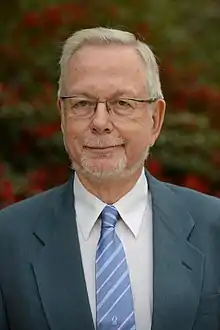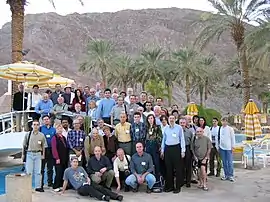Amnon Aharony
Amnon Aharony (Hebrew: אמנון אהרוני; born: 7 January 1943) is an Israeli Professor (Emeritus) of Physics in the School of Physics and Astronomy at Tel Aviv University, Israel and in the Physics Department of Ben Gurion University of the Negev, Israel. After years of research on statistical physics (critical phenomena, random systems, fractals, percolation), his current research focuses on condensed matter theory, especially in mesoscopic physics and spintronics.[1] He is a member of the Israel Academy of Sciences and Humanities,[2] a Foreign Honorary Member of the American Academy of Arts and Sciences[3] and of several other academies. He also received several prizes, including the Rothschild Prize in Physical Sciences,[4][5] and the Gunnar Randers Research Prize, awarded every other year by the King of Norway.[6][7]
Amnon Aharony | |
|---|---|
 | |
| Born | 7 January 1943 |
| Nationality | Israeli |
| Alma mater | Tel Aviv University, Hebrew university |
| Children | 3 |
| Awards | Rothschild Prize, Randers prize American Physical Society fellow, Foreign Honorary Member of the American Academy of Arts and Sciences, Member of the Israel Academy of Sciences and Humanities |
| Scientific career | |
| Fields | statistical physics condensed matter theory |
| Institutions | Tel Aviv University, Ben Gurion University of the Negev, University of Oslo |
| Thesis | Aspects of time reversal symmetry violation (1972) |
| Doctoral advisor | Yuval Ne'eman |
Early life and education
Amnon Aharony was born in Jerusalem, and grew up in Netanya, Israel. He received his B.Sc. in Physics and Mathematics in 1964 from the Hebrew university. His M.Sc. thesis, under the supervision of Gideon Rakavy, was on the distorted wave Born approximation for direct nuclear reactions (1965), from the same university. He received his doctorate in 1972 from Tel Aviv University, under the supervision of Yuval Ne'eman. Thesis title: Aspects of time reversal symmetry violation.[1]
Career
Aharony was a senior researcher in the Israel Army and Ministry of Defense during 1965–1972. In those years he was also a teaching instructor in Tel Aviv University. Aharony was a postdoctoral student at Cornell University with Michael Fisher,[8] and also at Harvard University, the University of California, San Diego and at Bell Laboratories in Murray Hill.
He returned to Israel in 1975 to become an associate professor of physics in Tel Aviv University, and a full professor in 1979. From 1990 he held the Moyses Nussenzveig Chair in Statistical Physics. Aharony retired from the university as Professor Emeritus in 2006. At that year he joined Ben Gurion University of the Negev, where he became Distinguished Professor Emeritus during 2013–2020.

During the years, Aharony was a visiting professor at Harvard University, MIT, Boston University, University of Tokyo, NTT Japan, the International Institute of Physics, UFRN, Natal, Brazil, the Institute for Advanced Studies in Jerusalem, the Institute of theoretical physics of the Chinese Academy of Sciences in Beijing. He was also a Distinguished Professor at the National Cheng Kung University, Taiwan and a visiting scientist at the IBM Research laboratories in Yorktown Heights and in Zurich, the US National Laboratories in Argonne and the National Institute of Standards and Technology (NIST), the Beijing Computational Science Research Center and the Institute for Basic Science in Daejeon, Korea. Aharony was also an adjunct professor in the University of Oslo, Norway during the years 1987–2012, and a Consultant at IBM Research, MIT and the Weizmann Institute of Science (1987–present).[1]
Research
Phase transitions: Aharony applied the renormalization group to identify and classify universality classes of critical (e.g. cubic, dipolar) and multicritical points.[8] [10] His work on random systems involved systems with random fields[11] [12] and the general issues of self-averaging.[13] Aharony introduced fractal geometry into several branches of statistical physics, especially in connection with the many fractal sub-structures of dilute percolating systems,[14][15] with applications to oil recovery.
Quantum magnetism: Aharony explained the structures and phase diagrams of magnetic oxide systems. This includes the magnetic structures of the high temperature superconducting parent cuprates, and the prediction of the spin glass phase there,[16] the discovery of a special symmetry in the Dzyaloshinskii-Moria interaction (now called the Shekhtman-Entin-Wohlman-Aharony symmetry)[17] and the ordered phases of various multiferroic materials.[18]
Mesoscopic physics: Aharony participated in critical discussions of the Aharonov-Bohm interferometer. [19] [20] [21] In recent years, he concentrates on the effects of the spin-orbit interaction on transport in mesoscopic spintronic systems, including proposals of spin filters which may be relevant to quantum information processing.[22] [23][24]
Publications
Aharony is the author of 8 books and more than 450 articles.[25] According to Google Scholar (September 2023) he has more than 50,000 citations and his h-index is 87.[26]
Selected books
- A. Aharony and J. Feder, editors. Fractals in Physics. Proceedings of a Conference, Vence, France (North Holland, Amsterdam, 1989)
- D. Stauffer and A. Aharony. Introduction to Percolation Theory. Taylor and Francis, London (1992); revised 2nd edition (1994);[27] German translation: Perkolationstheorie, Eine Einführung, VCH, Weinheim (1995); Japanese translation: PA-KO RE-SHON NO KI HON GEN RI, Yoshiokashoten, Kyoto (2001).
- A. Aharony and O. Entin-Wohlman, editors. Perspectives of Mesoscopic Physics. World Scientific, Singapore (2010)[28]
- A. Aharony and O. Entin-Wohlman. Introduction to Solid State Physics. In Hebrew, Open University, Israel (2018), 600 pages;[29] English translation: World Scientific, Singapore (2018)[30]
Honors and awards
- Fulbright Fellowship, US, 1972
- Fellow, American Physical Society, USA, 1985, "for contributions to the theory of new critical and multicritical points, of random field systems and their experimental realization and of using fractals in statistical physics and in percolation"[31]
- Foreign Member, Norwegian Academy of Science and Letters, Oslo, Norway, 1988
- Member, Royal Norwegian Society of Sciences and Letters, Trondheim, Norway, 1993
- Foreign Honorary Member, American Academy of Arts and Sciences, Cambridge, MA, USA, 2002[3]
- Honorary fellow, Institute of Physics, UK, 2011
- Elected member, Israel Academy of Sciences and Humanities, 2012[2]
Notable students
Personal life
Aharony is the father of Professor of Physics Ofer Aharony,[32] psychologist Dr. Tamar Aharony and Professor of music Iddo Aharony.[33]
References
- Prof. Amnon Aharony, Tel Aviv University
- Prof. Amnon Aharony, Israel Academy of Sciences and Humanities
- Professor Amnon Aharony, American Academy of Arts and Sciences
- The Rothschild Prize in the Physical Sciences, Tel Aviv University
- "Rothschild Prizes 2010 - 50 Years". ISSUU. 15 April 2020. Retrieved 3 May 2022.
- The Gunnar Rander's Research Prize is awarded to professor Amnon Aharony for outstanding scientific achievements, Institute for Energy Technology
- "Randerspris for supraledning". Forskning (in Danish). 6 March 2005. Retrieved 3 May 2022.
- Aharony, A.; Fisher M. E. (1973). "Critical Behavior of Magnets with Dipolar Interactions. I. Renormalization Group near Four Dimensions". Physical Review B. 8 (7): 3323–3341. Bibcode:1973PhRvB...8.3323A. doi:10.1103/PhysRevB.8.3323.
- "The Transport and Magnetism conference poster". Tel Aviv University.
- Aharony, A. (1976). Domb, C.; Green, M. S. (eds.). "Dependence of universal critical behavior on symmetry and range of interaction". Phase Transitions and Critical Phenomena. 6: 357–424.
- Aharony, A.; Imry Y.; Ma S. (1976). "Lowering of Dimensionality in Phase Transitions with Random Fields". Physical Review Letters. 37 (20): 1364–1367. Bibcode:1976PhRvL..37.1364A. doi:10.1103/PhysRevLett.37.1364.
- Fishman, S.; Aharony A. (1979). "Random field effects in disordered anisotropic antiferromagnets". Journal of Physics: Condensed Matter. 12 (18): L729–L733. Bibcode:1979JPhC...12L.729F. doi:10.1088/0022-3719/12/18/006.
- Aharony, A.; Harris A. B. (1996). "Absence of Self-Averaging and Universal Fluctuations in Random Systems near Critical Points". Physical Review Letters. 77 (18): 3700–3703. Bibcode:1996PhRvL..77.3700A. doi:10.1103/PhysRevLett.77.3700. PMID 10062286.
- Gefen, Y.; Aharony A.; Alexander S. (1983). "Anomalous Diffusion on Percolating Clusters". Physical Review Letters. 50 (1): 77–80. Bibcode:1983PhRvL..50...77G. doi:10.1103/PhysRevLett.50.77.
- Aizenman, M.; Duplantier B.; Aharony A. (1999). "Path-Crossing Exponents and the External Perimeter in 2D Percolation". Physical Review Letters. 83 (7): 1359–1363. arXiv:cond-mat/9901018. Bibcode:1999PhRvL..83.1359A. doi:10.1103/PhysRevLett.83.1359. S2CID 119152506.
- Aharony, A.; Birgeneau R. J.; Coniglio A.; Kastner M. A.; Stanley H. E. (1988). "Magnetic phase diagram and magnetic pairing in doped La2CuO4". Physical Review Letters. 60 (13): 1330–1333. Bibcode:1988PhRvL..60.1330A. doi:10.1103/PhysRevLett.60.1330. PMID 10038007.
- Shekhtman, L.; Entin-Wohlman O.; Aharony A. (1992). "Moriya's anisotropic superexchange interaction, frustration, and Dzyaloshinsky's weak ferromagnetism". Physical Review Letters. 69 (5): 836–839. Bibcode:1992PhRvL..69..836S. doi:10.1103/PhysRevLett.69.836. PMID 10047045.
- Lawes, G.; Harris A. B.; Kimura T.; Rogado N.; Cava R. J.; Aharony A.; Entin-Wohlman O.; Yildirim T.; Kenzelmann M.; Broholm C.; Ramirez A. P. (2005). "Magnetically Driven Ferroelectric Order in Ni3V2O8". Physical Review Letters. 95 (8): 087205. arXiv:cond-mat/0503385. Bibcode:2005PhRvL..95h7205L. doi:10.1103/PhysRevLett.95.087205. PMID 16196898. S2CID 17131264.
- Aharony, A.; Entin-Wohlman O.; Halperin B. I.; Imry Y. (2002). "Phase measurement in the mesoscopic Aharonov-Bohm interferometer". Physical Review B. 66 (11): 115311. arXiv:cond-mat/0205268. Bibcode:2002PhRvB..66k5311A. doi:10.1103/PhysRevB.66.115311. S2CID 117239942.
- Entin-Wohlman, O.; Aharony A.; Imry Y.; Levinson Y.; Schiller A. (2002). "Broken Unitarity and Phase Measurements in Aharonov-Bohm Interferometers". Physical Review Letters. 88 (16): 166801. arXiv:cond-mat/0108064. Bibcode:2002PhRvL..88p6801E. doi:10.1103/PhysRevLett.88.166801. PMID 11955245. S2CID 45053988.
- Aharony, A.; Entin-Wohlman O.; Otsuka T.; Katsumoto S.; Aikawa H.; Kobayashi K. (2006). "Breakdown of phase rigidity and variations of the Fano effect in closed Aharonov-Bohm interferometers". Physical Review B. 73 (19): 195329. arXiv:cond-mat/0512384. Bibcode:2006PhRvB..73s5329A. doi:10.1103/PhysRevB.73.195329. S2CID 73594910.
- Aharony, A.; Tokura Y.; Cohen G. Z.; Entin-Wohlman O.; Katsumoto S. (2011). "Filtering and analyzing mobile qubit information via Rashba–Dresselhaus–Aharonov–Bohm interferometers". Physical Review B. 84 (3): 035323. arXiv:1103.2232. Bibcode:2011PhRvB..84c5323A. doi:10.1103/PhysRevB.84.035323. S2CID 118339298.
- Matityahu, S.; Aharony A.; Entin-Wohlman O.; Balseiro C. A. (2017). "Spin filtering in all-electrical three-terminal interferometers". Physical Review B. 95 (8): 085411. arXiv:1611.01832. Bibcode:2017PhRvB..95h5411M. doi:10.1103/PhysRevB.95.085411. hdl:11336/65906. S2CID 119125978.
- Entin-Wohlman, O.; Shekhter R. I.; Jonson M.; Aharony A. (2020). "Photovoltaic effect generated by spin-orbit interactions". Physical Review B. 101 (12): 121303(R). arXiv:1911.01168. Bibcode:2020PhRvB.101l1303E. doi:10.1103/PhysRevB.101.121303. S2CID 207870722.
- Prof. Amnon Aharony - List of publications, Tel Aviv University
- Amnon Aharony, Google Scholar
- Introduction To Percolation Theory, Taylor & Francis
- Aharony, Amnon; Entin-Wohlman, Ora (2010), Perspectives of Mesoscopic Physics, World Scientific, doi:10.1142/7680, ISBN 978-981-4299-43-5
- Introduction to Solid State Physics (in Hebrew), Open University of Israel
- Aharony, Amnon; Entin-Wohlman, Ora (2018), Introduction to Solid State Physics, World Scientific, doi:10.1142/11041, ISBN 978-981-327-224-8, S2CID 126007444
- APS Fellow Archive, American Physical Society
- Prof. Ofer Aharony, Weizmann Institute of Science
- Iddo Aharony, Colorado College
External links
- Amnon Aharony, Ben Gurion University
- Prof. Amnon Aharony, Tel Aviv University
- A lecture by Amnon Aharony: Quantum theory: does God play dice? (in Hebrew), YouTube